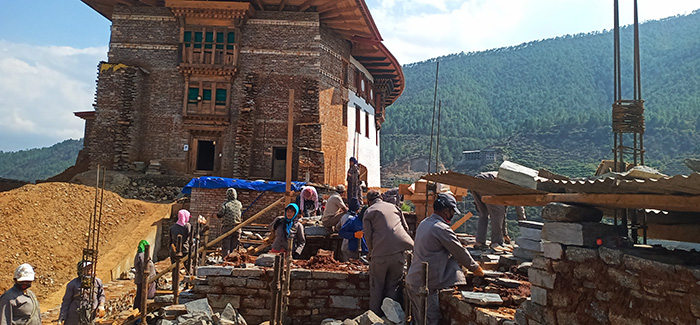Phurpa Lhamo | Wangdue
On June 24, 2012, Phurba witnessed the Wangdue Dzong go up in flames. There was little he could do to save the iconic national treasure. Benumbed with grief and shock, he watched from the opposite hill—Rinchengang—raging winds fuelling the inferno. Then it was gone, almost to the rubble.
Phurba is today the reconstruction project’s head mason. Pay is small and toil back-breakingly arduous, but he goes on because on that fateful day he promised unto himself that he would give his heart, soul, and sweat to rebuilding the country’s singularly unique and important heritage centre.
Unlike Phurba, many—almost 50 persons—have left the project because of poor pay. The workers are paid a minimum wage of Nu 215 and a maximum of Nu 486 per day. The project today has 249 workers—all Bhutanese. They are mostly from Tsirang and Dagana.
Project director Kinley Wangchuk said that the project was proposing incentives for the workers who have spent long time constructing dzongs.
“We are proposing a pay raise and incentives for those who have worked for a long duration in construction of dzongs. I have seen people leave a project without anything when a construction project ends.”
Kinley Wangchuk suggested providing a monthly incentive or allowance to workers depending on work to encourage young Bhutanese to take up dzong construction work.
Today, with limited workforce, both skilled and unskilled workers are engaged in overtime work.

Around 50 workers left in 2019-2020 fiscal year. Poor pay has been a major reason.
According to Phurba, 53, many school dropout work for around four to five months and leave due to poor pay. “They don’t have an option.
Private firms provide pay Nu 700 for masonry work and, with limited workforce, the pay increases to Nu 1000. If the pay is raised, young people would be really encouraged.”
Despite shortage in workforce, the progress of the dzong construction project is on track. Construction work is expected to be completed in 2022. About 76 percent of work has been completed.
In the middle courtyard, while work seems slow from the outside, the foundations and raft slabs have already been laid. The service tunnel, which runs through the three courtyards, is in progress.
“Unlike traditional dzongs, we have modern technologies incorporated in the dzong,” Kinley Wangchuk said.
Also, laying of the raft slabs, which are usually done by Indian workers, are today done by Bhutanese workers.
As part of the project, Rada Lhakhang near the dzong has also been reconstructed. Painting work has begun.
Simultaneously, the Nangten Khodrup Tshogpa, led by the dzongkhag’s Lam Neten is also installing important relics and religious instruments and statues in the completed lhakhangs.
According to the tshogpa’s secretary, Lhatu, work to make around 67 statues was in progress in Thimphu.
He added that around 25 were already installed in the dzong. “We have completed around 80 percent of our work.”
Today the tshogpa is also asking for samples before confirming work to ensure quality of the instruments, materials and clothing to be installed in the dzong.
“We cannot risk having poor quality materials. Unlike the physical structures we cannot have separate budget for renovation or so,” Lhatu said.
The project has today spent Nu 689 million. The tshogpa has spent Nu 85 million.
However, due to Covid-19 pandemic the project has today stopped tokha and volunteers for safety reasons.
“We have stocked the materials and have no issues,” said Kinley Wangchuk.


